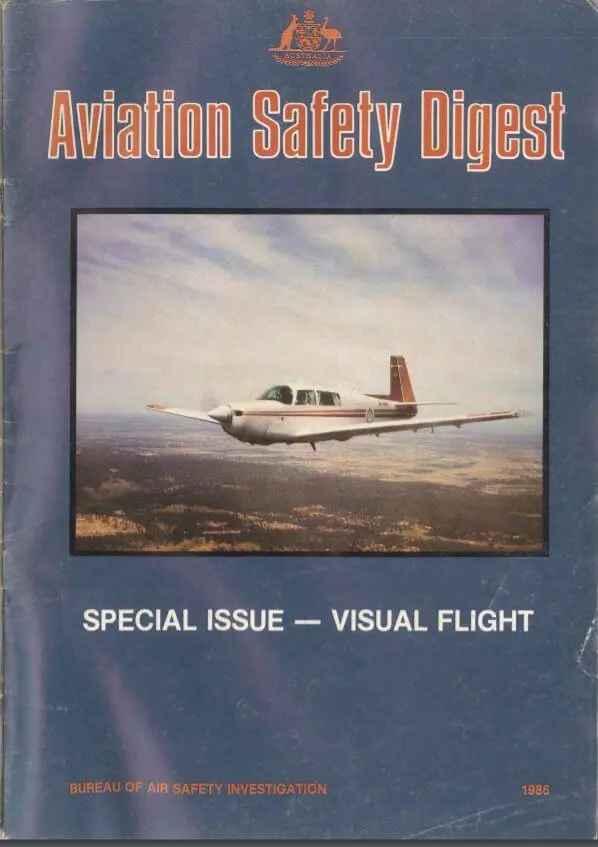The full collection of the Aviation Safety Digests is available for download via the following link:
A history of the publication is below:
Universally known and loved throughout the Australian aviation industry as the ‘crash comic’, for nearly forty years the Aviation Safety Digest was an icon. This history of the Digest is largely taken from an article written by legendary Digest editor Macarthur Job for the 100th edition and updated by Phil Vabre.
During the austere days of war, civil aviation in Australia had been cut to the bone, strategic airlines and outback medical services being virtually the only exceptions. But with the war’s end in August 1945, civil flying quickly resumed and, perhaps more than any other public activity, was plagued with the difficulties of transitioning from the exigencies of war to the different but equally demanding disciplines of peace.
The mood of the times was hardly an ideal one in which to develop a high standard of conformity to operational procedures. Pilots taking up civil flying were for the most part men freed from the constraints of service life who had sharpened their skills in the climate of action against the enemy and had been thoroughly conditioned to calculated risk-taking. Added to this was the fact that ex-disposal aeroplanes, particularly Tiger Moths, Dragons and Ansons, could be had almost for a song and were available in quantity. Small wonder then that something of a cavalier attitude tended to prevail as newly-founded commercial and private operations began to proliferate. Inevitably the number of aviation accidents began to rise.
Because of the difficulties in which the industry found itself, the newly structured Department of Civil Aviation saw the need to examine the problem in depth, and in 1946 an Accident Studies Branch was formed as part of the then Directorate of Air Navigation. As it set about gathering information from which to develop safety standards, this Branch found that the relatively small number of accident reports available made it difficult to draw worthwhile conclusions from accident statistics alone. The Branch therefore saw a need for some system of industry report, not only for actual accidents, but for any instance in which the safety of an aircraft was compromised. Thus the air safety incident reporting system, then unique to Australia, was born.
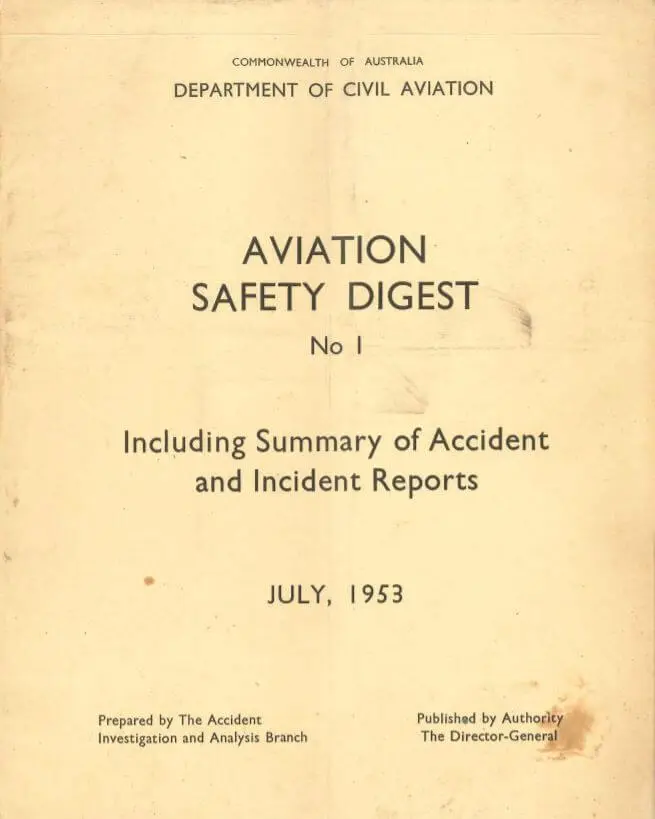
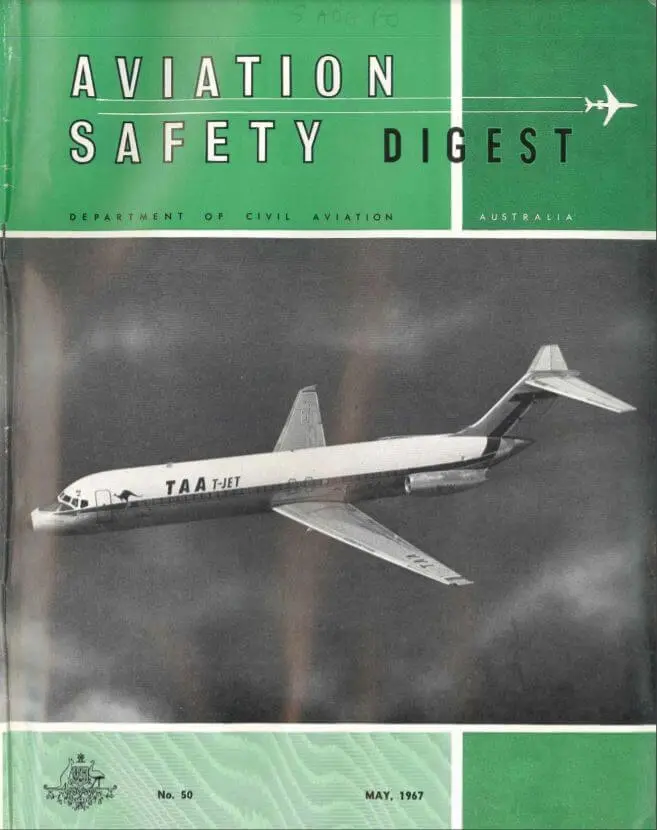
Through the new incident system many deficiencies came to light, but at first only those directly associated with them knew of the consideration a report had been given, or of the resulting action. Before long however, it was evident that there would be benefit in publicising these findings for the edification of the whole industry. And so it was in March 1948 that the Department’s Monthly Summary of Incident Investigations consisting of six roneoed pages stapled to a blue paper cover first found its way to the offices of airlines, charter and aerial work operators, and aero clubs. Limited by an extremely tight budget, only 400 copies were available for this initial distribution. But even this did not daunt the prophetic note of its editorial: “…it is felt that the educative data from such reports would prove most informative and beneficial if accorded a wider circulation.”
How right it was! Interest in the summary grew and in 1950 its content was expanded to include local and overseas accidents. And with these changes the new title Summary of Accident and Incident Investigations was adopted.
Not long after this time, the Accident Studies Branch and the Department’s Accident Investigation Branch, both of which had been separate entities, were merged to form the group which later developed to become the Air Safety Investigation Branch (ASIB). The merger added impetus to the need for accident prevention through safety education and in June 1953 the Accident and Incident Summary as it had come to be known, found fulfilment in a new publication, printed letterpress with a yellow board cover under the inspired title Aviation Safety Digest. The first issue offered a greatly improved type of presentation and for the first time was distributed individually to all licence holders. “For some time we have been of the opinion that the wide interest displayed in the Accident and Incident Summary merited better presentation of this material,” explained the Foreword. “Our efforts have resulted in the Aviation Safety Digest, the first edition of which we now present.”
Though from the first the Digest was to be issued quarterly, its production schedule soon ran into difficulties. At that stage the preparation of articles was the responsibility of the normal air safety investigation staff – there was no Digest staff as such. Not long after Digest No 3 had been distributed the first Australian-registered Viscount crashed during a training exercise at Mangalore. The subsequent investigation taxed the resources of the Branch to the limit, and it was almost a year before the next issue of the Digest – a small edition containing only the Mangalore accident report – was in the hands of its readers. A series of other fatal accidents requiring major investigations followed, with the result that again more than 12 months were to elapse before the Branch could recover sufficiently to produce Digest No 5 in February 1956.
The full collection of the Aviation Safety Digests is available for download via the following link:
From that time on production became reasonably regular but as the Branch became increasingly taken up with day-to-day investigation work, those responsible for the Digest were forced to depend more and more on content adapted from overseas safety publications. So much so that by 1959 the comment most often heard on the Digest was ‘not enough Australian stuff’. Even so the presentation of the magazine continued to improve and in Digest No 14 the traditional yellow board cover was dropped in favour of glossy art paper. The Digest was beginning to look like a magazine!
As issue succeeded issue the rapidly expanding aviation industry was demanding still more of the Branch’s effort, and it was finally realised that the only solution to the problem of issuing the Digest regularly was to appoint specialist staff to produce the magazine. Accordingly, in 1964, the Digest gained its first full-time editor, Macarthur ‘Mac’ Job, his first task being to make good the four-month production lag that had developed over the years and to ‘Australianise’ its content. Emphasis was also given to including effective illustrations to support and enhance the message of the text.
By 1967, in response to many requests from readers and with the increased safety information available from a burgeoning aviation industry, the Branch felt the time had come to increase the frequency of the Digest from four to six issues a year. To cope with the increased workload an assistant editor was appointed and appropriately the new policy was announced in Digest No 50. “With this, its fiftieth issue, Aviation Safety Digest takes a further step forward in serving the interests of air safety…” explained the editorial, “…the Department hopes the publication will be able to more effectively fulfil its function…and that all who have a part to play in the operation of aircraft…will strive for operations that are as accident free as it is humanly possible to make them.”
All this time the number of licence holders receiving the Digest, free of charge, had been steadily growing. By the beginning of 1972 the production run of copies had reached a point where a change from letterpress to offset printing became economical. This immediately gave scope for greater flexibility in lay-out with the result that more imaginative design and illustration began to characterise the Digest from issue No 79 onwards. The effectiveness of the presentation and content gained international recognition in 1972 when the United States Flight Safety Foundation named the Digest as its ‘Publication of the Year’. A further step in the evolution of the Digest was taken in 1973 when, with the issue of Digest No 86 the standard international A4 size was adopted in place of the original smaller format. Although, for a variety of reasons, the Digest had some difficulty maintaining its objective of six issues per year, there was some consolation that a typical issue of the Digest contained almost twice as much copy as did Digest No 50 and its contemporaries. Click here to see a photo of the editorial team at this time.
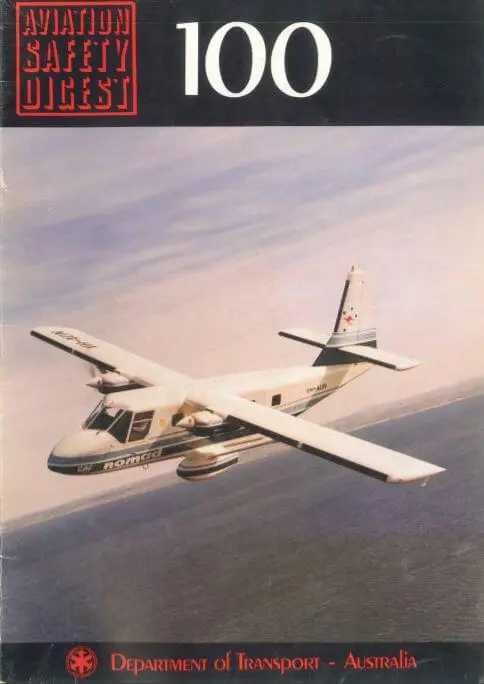
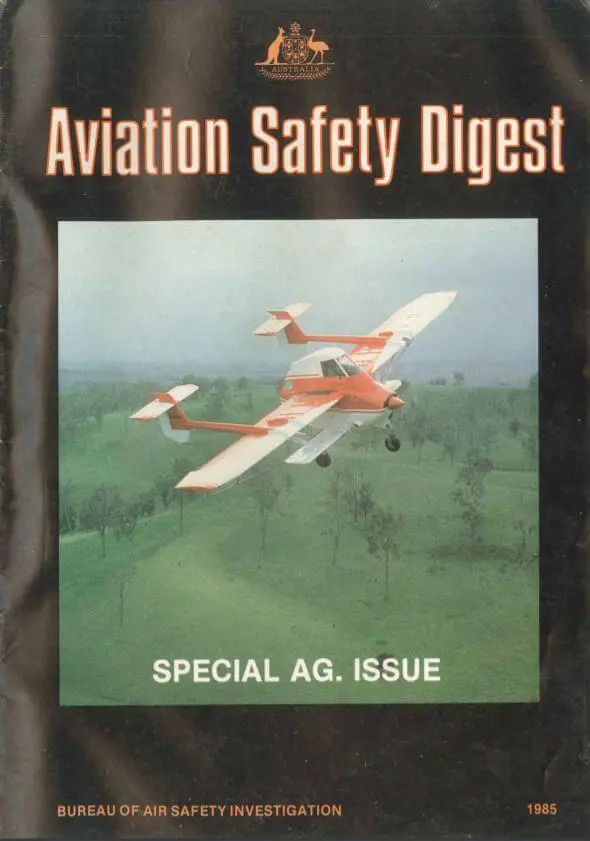
The Digest carried on at its usual high standard. Of particular note, 1976’s Digests No 96 & 97 were ‘Special Reference Editions’ in which articles from previous Digests, suitably updated, were collected in an attempt to, as the editorial put it, “…not only meet the needs of pilots new to the industry, but also serve to refresh the understanding of those practising pilots who have forgotten some of the classic, oft-repeated operational situations which can be accidents in the making.” Digest No 100 of 1977 provided a chance to look back at what had been achieved over the previous 24 years, from which the foregoing material has been taken.
Not long after however, a blow came when long-serving editor Macarthur Job, who had done so much to improve the Digest, left the Department. With Mac’s departure came a subtle change in style and balance. Although still containing much good and useful information the Digest became drier, lacking the consistency of Mac’s unique ability to write in a way that spoke to everyman – to get the safety message across in an enjoyable yet pungent manner.
Budgetary problems also began to affect the Digest. In No 114 of 1982 an editorial by the new Secretary of the Department announced the creation of the Bureau of Air Safety Investigation as an independent entity within the Department, to which the Digest would belong. He also stated: “Finally, it has been brought to my attention that there have been statements by various sources that publication of the Aviation Safety Digest is to be discontinued. I hasten to assure you that this is not the case.” He went on to explain, “The frequency of the magazine has been restricted in recent times by difficulties in recruiting and retaining suitable personnel within the Bureau of Air Safety Investigation. The consequent staff shortage resulted in a situation where the exigencies of day-to-day accident investigation had to take precedence, temporarily, over the requirements of the Digest.”
Digest No 117 of 1983 introduced a new feature which would remain part of the Digest until 1988. This was a section containing a Summary of Aircraft Accidents – short descriptions of all accidents that either occurred or had reports finalised in the previous quarter (the Digest having once again settled on being a quarterly issue).
Nineteen-eighty-six saw another major change to the Digest when it was transferred from BASI to the Flight Standards Division of the Department, ending its thirty-two year association with the safety investigation branch. A final editorial by the Director of BASI in No 128 explained “The…Digest was part of the Bureau’s safety education unit. With the transfer of this unit to Flight Standards it will be possible to achieve better co-ordination of regulatory and safety education functions by having both under the control of the one division. It is also important that the Bureau should not be seen to have the dual role of investigator and educator.” Prior to the transfer, the Bureau also produced a special on Visual Flight.
Some of the difficulties of the previous years were overcome when David Robson was appointed as the new editor from Digest No 131 of Summer 1986/87 with a promise to “make the magazine more positive, more constructive and more readable.” The Digest took on a new style and focus. A major step was the issue of well-received specials The Human Factor and Gliding in 1986, and in 1987 the US Flight Safety Foundation again awarded the Aviation Safety Digest its best publication award. The editorial recording this award also commented, “Equally important was the news from W.A. that the Digest is so well regarded that it is hung on a string in the ‘loo’.”
The Spring of 1988 issue of the Digest, No 138, saw the announcement of the formation of the Civil Aviation Authority, under which the Digest would continue to be produced – and also the departure of editor David Robson. The editorial in No 139 reported on the results of a readership survey. In contrast to the results of an earlier survey in 1978 when 63% of readers surveyed responded, only 61 returns were received from 40,000 questionnaires distributed. The editorial noted that “This may be accounted for by the comment offered by one respondent on a photocopy of the survey page. ‘I don’t like cutting up my Digests’.” The editorial also announced that feedback had been received that readers missed the Summary of Accidents section and that BASI would be producing their own journal which would in the future be distributed with the Digest.
It could be said that the separation of the Digest from its roots in the air safety investigation organisation sowed the seeds of its eventual downfall. The Digest was no longer the ‘crash comic’ that was known and loved. Its home in the Civil Aviation Authority, an organisation becoming more and more focused on economic matters, did not sit easily. A succession of editors, first Al Bridges for two issues and then Roger Marchant did not help matters. Finally, thirty-eight years of service to the industry came to an end in 1991 when a terse statement by the General Manager, Safety Regulation and Standards Division in Digest No 150 announced that the earlier readership survey “…indicated inadequate support to warrant [the Digest’s] continuation…”, and the abrupt end of the Aviation Safety Digest.
The editorial for that final issue did perhaps have the last word by quoting from the acceptance speech of one of the winners of a 1991 photographic competition organised by the Digest. Of the Digest, Lindsay Stepanow had this to say: “…as for the Digest, it’s been a constant with pilots over the decades. Rules, charges and aeroplanes may change over the years, but ASD has always been there. It dispenses advice that on occasion may seem obvious (sometimes you think ‘Bloody fool! How’d he get his licence?’), but most of the time you think ‘Gee, I’m glad someone told me about that before it happened to me’. The magazine gives you more of a chance to combat the cruel tricks that Fate and Nature can play, and for the non-professional pilot, whose experience and currency levels may be variable, it is a way to acquire constant updating of aviation knowledge, particularly through the hard-earned experience of others.”
Sources:
Airways Museum & Civil Aviation Historical Society
